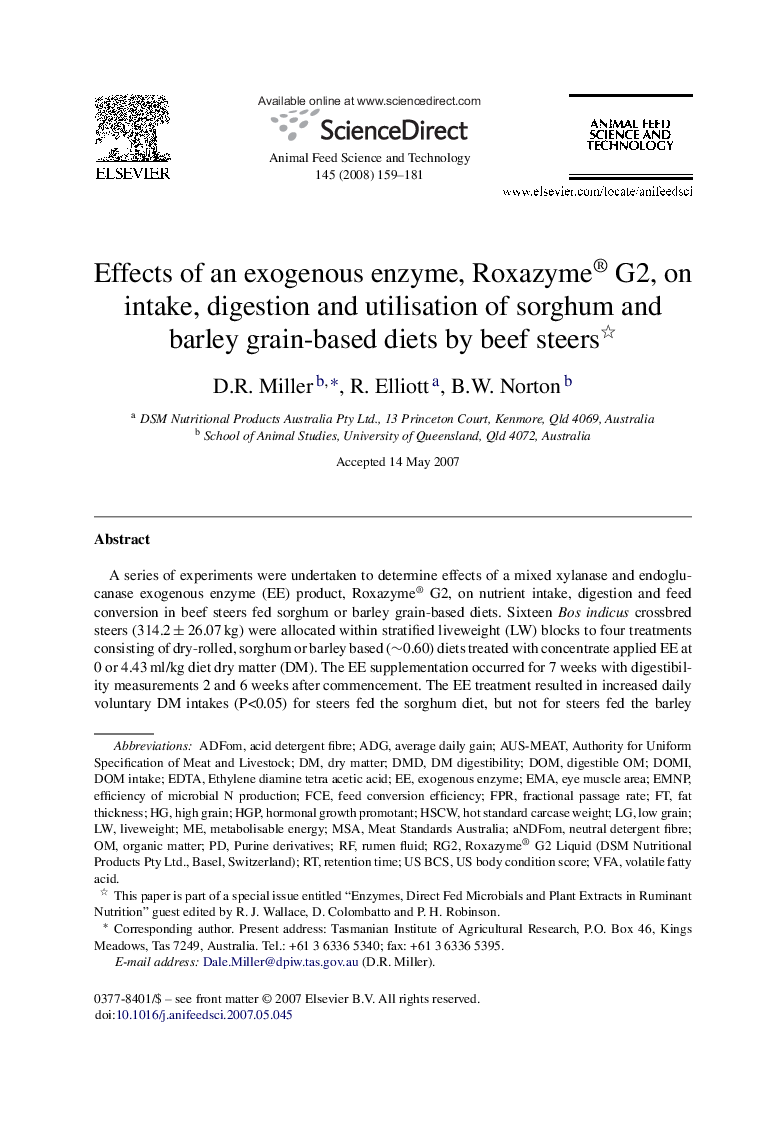| کد مقاله | کد نشریه | سال انتشار | مقاله انگلیسی | نسخه تمام متن |
|---|---|---|---|---|
| 2420634 | 1552467 | 2008 | 23 صفحه PDF | دانلود رایگان |

A series of experiments were undertaken to determine effects of a mixed xylanase and endoglucanase exogenous enzyme (EE) product, Roxazyme® G2, on nutrient intake, digestion and feed conversion in beef steers fed sorghum or barley grain-based diets. Sixteen Bos indicus crossbred steers (314.2 ± 26.07 kg) were allocated within stratified liveweight (LW) blocks to four treatments consisting of dry-rolled, sorghum or barley based (∼0.60) diets treated with concentrate applied EE at 0 or 4.43 ml/kg diet dry matter (DM). The EE supplementation occurred for 7 weeks with digestibility measurements 2 and 6 weeks after commencement. The EE treatment resulted in increased daily voluntary DM intakes (P<0.05) for steers fed the sorghum diet, but not for steers fed the barley diet. Daily LW gain increased numerically on both diets (920 g/d versus 740 g/d, P=0.138) with no changes in feed efficiency. The EE treatment had no effect on total tract OM or fibre digestibility, but interacted with diet (P<0.05) whereby sorghum starch digestibility at 6 weeks was reduced by EE treatment (0.68 versus 0.81 control) without change in barley starch digestion (0.96). The EE supplements also increased (P<0.05) urinary N excretion. In a second 4 × 4 Latin Square experiment with 24 d periods, ruminally cannulated B. indicus crossbred steers (364.3 ± 21.98 kg, n = 4) were fed sorghum grain diets, either as in the first experiment or at reduced grain levels (0.35 of diet DM), and untreated or treated with EE (4.18 ml/kg diet DM) as previously. Under these conditions, EE treatment had no effects on feed intake, total tract digestibility or ruminal fermentation measurements. A marker dilution technique indicated that EE treatment reduced (P<0.05) the fractional passage rate of a grain-associated marker when applied to the high grain diet, while increasing it on the low grain diet, but EE did not affect fluid or fibre marker flows from the rumen. Ruminal in sacco incubations of 3 mm ground pangola grass (Digitaria decumbens) or sorghum grain revealed a reduction (P<0.01) in the insoluble potentially degradable fraction of the grass with EE supplementation, likely due to reduced (P=0.058) anaerobic fungi colonisation, and a tendency (P=0.082) for increased extent of grain DM disappearance. A 70 d feedlot experiment used 96 Santa Gertrudis steers (351 ± 25.3 kg) allocated in balanced groups to one of four replicates of four levels of EE supplementation (i.e., 0, 1.08, 2.16, 4.33 l/tonne DM total ration) applied to a high quality, dry-rolled sorghum (0.72 of DM) finishing ration. The EE had no effect on DM intake (120 g/kg LW0.75), LW gain (1.92 kg/d), feed efficiency (5.72 kg DM/kg LW gain) or carcase attributes. A mixed activity EE product fed to beef cattle had dietary dependant (both type and composition) effects on feed intake, starch and N digestion, microbial efficiency, grain marker flow rates and the extent of in sacco degradation of a grass forage. However, production performance and carcase measures were not effected by adding the EE to a high quality feedlot diet fed to growing steers.
Journal: Animal Feed Science and Technology - Volume 145, Issues 1–4, 14 August 2008, Pages 159–181